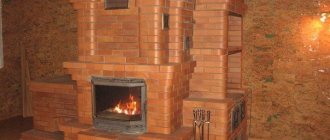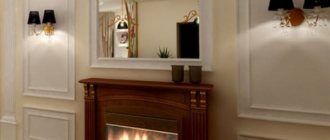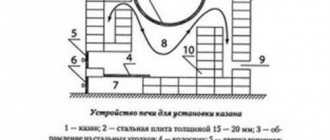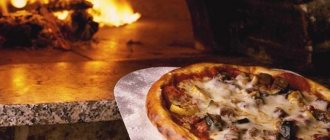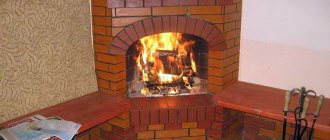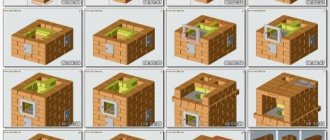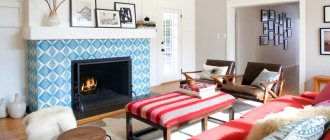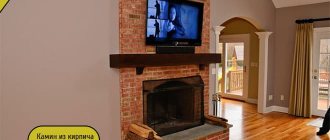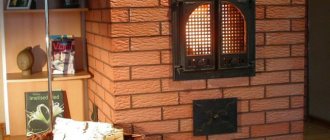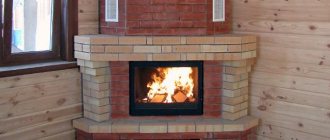Making a fireplace out of brick is quite difficult. To create a high-quality and productive structure, you will first need a well-designed order or project. The design features of the equipment and the materials used for assembly play an equally important role.
A fireplace with your own hands can be placed both in a private country cottage and in a country house. First of all, this heating variation is suitable for those rooms in which there is no other source of receiving and generating thermal energy. Such a stove can be installed in a house made of brick or wood. Installation in a building made of logs or gas silicate block is also possible. A properly designed fireplace design allows you to efficiently heat not only a small house, but also a fairly large and even two-story house. The efficiency of such a design can reach about 80-90 percent. This is considered a high and good indicator.
Design Features
Having heard about fireplace stoves for the first time, owners of country houses often shrug their shoulders: why waste effort on building a heating device of such a design, if you can build one of the well-proven stoves such as a Dutch oven, a Swede stove, a kolpakovka stove, etc. That’s all. the fact is that they do not know the operating features of fireplace stoves, but during their development they combined all the best from two completely different heating devices.
Combining a stove with a fireplace allows you not only to heat the room efficiently, but also to make its interior unforgettable
The main advantage can be considered that to heat the room, you can use two modes of operation of the dual heat generator.
Fireplace mode
In this case, the smoke from the fireplace will be directed through a special smoke collector into a flue located on the rear wall of the heating device and then directly into the chimney. The construction of an almost straight channel avoids a decrease in draft, so the intensity of firewood combustion will be maximum.
Using a heating unit as a fireplace is very convenient for irregular fires, for example, in a country house or in country houses, where people visit only on weekends in winter. In this case, the temperature in the room will become comfortable literally within one hour.
Advantages of the stove
Combustion products do not “fly out into the chimney,” as is the case with a fireplace, but are redirected into additional channels located on the sides of the heating device, where they transfer all the heat to the walls of the structure. The duration of combustion of the same amount of fuel during furnace combustion increases significantly, since the operation of the unit most often occurs at the border of smoldering. This is achieved by adjusting the air flow through the blower. Thanks to the expansion of the furnace array, it has improved heat-accumulating properties and allows the accumulated heat to be released for a long time even after complete combustion of the fuel.
If irregular operation is expected, then most often the heat generator is operated according to the following scheme:
- When kindling, a vertical channel is opened, which switches the unit to fireplace mode.
- After the temperature in the room rises to a comfortable level, close the valve of the vertical channel and close the ash door to maximize the combustion duration.
As you can see, the fireplace stove is a successful symbiosis of several heating devices. However, its advantages do not end there.
Using a fireplace cassette increases the hygiene of the design and facilitates the construction of the heating device
Heating devices can be made with either an open or closed fireplace insert. In the latter case, a door made of heat-resistant glass or a special cast-iron cassette (liner) is used. Limiting the amount of incoming air allows you to increase the operating time of the fireplace and increase its efficiency.
Determining the location of the stove in the house
Since the stove must perform two functions: cooking and heating, it must be placed so that it meets its functionality. In addition, it is necessary to take into account fire safety rules.
Conditions you need to know when placing:
- Installation near wooden or other easily flammable walls is not allowed;
- a window or additional exhaust ventilation must be provided in the room;
- Ideally, the firebox is placed in the corridor or in the utility room;
- it is necessary to ensure free access to the combustion chamber and chimneys for their timely cleaning.
If you plan to heat one room, then it is best to install the heating device in the center. It is possible to provide heat to several rooms if the partitions are placed at the joints.
Important! When the heating and cooking stove is located close to the outer wall, heat loss is inevitable.
Types of fireplace stoves
The design discussed above is the simplest implementation of the idea of a fireplace-stove. In fact, there are much more efficient and functional structures that combine a separate fireplace and stove, install a hob, oven or heat exchange niches, etc.
Fireplace stove with bench
Fireplace stove with bench
A massive structure with a heated lounger or stove is not suitable for every home. For example, for a summer house it will be too big, since it will occupy a significant area of the room. If you install such a unit in a country house, you can achieve amazing comfort: such a design just begs to be installed in a living room combined with a kitchen.
Wall fireplace stove
A wall-mounted fireplace stove will save space in a small room
This design can be built in a small house to heat two adjacent rooms. As in the design discussed above, heating units can be heated separately. In this case, the fireplace can be used to quickly and comfortably heat a large room, while the heating of the back wall during operation of the stove will work to heat the bedroom. The disadvantage of this design can be considered the absence of a hob, which, however, is compensated by the compactness of the structure.
Square fireplace stove with stove and oven
Multifunctional fireplace stove with stove and oven
A multifunctional heating device installed in a large room can divide it into several zones. On the side of the fireplace, you can create a cozy homely atmosphere for relaxing and gathering with friends, while the area adjacent to the stove can be used for cooking and other household needs. Fortunately, for this purpose the fireplace stove has a large hob and a spacious oven. The shelf above the fireplace can also be used to the maximum - it is convenient to dry fruits, mushrooms or medicinal plants on it.
Stylistics
A well-chosen fireplace should be combined with the overall style of your interior. Only then will such an addition look beautiful. Fireplace stoves are often made independently or to order. The Finnish model is quite popular. Let's look at the most popular styles in which this unit is made:
Minimalism
Minimalism is characterized by strict forms and lines. In houses of this style, small fireplaces are installed, which serve a decorative and heating role. A laconic design with a minimum number of decorative parts is the perfect set. Any room in your home will become even more cozy when it has a mini fireplace.
A small fireplace stove will fit well into a minimalist interior and will delight you and your guests. In addition, this option is well suited for houses with a small area. Here you can also install a structure in which the stove will face the kitchen, and the fireplace itself will face the living room.
Classic
Fireplaces of this style were the first. They were installed by noble people as an interesting piece of furniture and a sign of their superiority. Such fireplace stoves always have the correct shape and only expensive finishing or carving.
Such units usually go flush with the wall. This arrangement determines the main decorative accent on the firebox itself. All designs of such furnaces include a U-shaped portal. But you can also choose a non-embedded option. In this case, the fireplace stove is located against the wall, and the chimney is covered with a stylized casing.
Modern
This type of fireplace stove is often chosen by young people. You can buy a lot of interesting options. Such units are often used as architectural details. These fireplaces are often installed so that they blend into the wall and resemble a window with a fire. An interesting option is when a double-sided fireplace stove is installed in the interior wall. With this arrangement, you can use the structure as a piece of furniture on one side, and on the other as a stove.
Rustic
These are country style fireplaces. This design will look good in a wooden house. Natural wood ceilings, harmoniously selected wall finishes and dark floors. Moreover, using wallpaper in this case is completely impractical. They will quickly become unusable due to the stove. A Russian stove works well. Carved decorative elements will add originality and exclusivity.
Venetian
Fireplace stoves of this style are quite massive and clearly stand out against the background of the wall. They are designed to show everyone around their power and sophistication in one person. In an interior of the appropriate style, such fireplaces look like a charming integral attribute.
Advantages and disadvantages of combined heating devices
The advantages of fireplace stoves include:
- the ability to quickly heat the room;
- good heat storage capacity;
- high performance;
- heat transfer at the level of the best heating units;
- versatility;
- possibility of using for heating several rooms;
- increased emissivity;
- the presence of additional functional elements for cooking, drying clothes or relaxing.
As for the disadvantages, these include low efficiency and uneconomical design operating in fireplace mode, the need to clean additional smoke channels, the need for good ventilation and high-quality air flow. An obvious disadvantage is the complexity of the design, as well as the impressive dimensions of the structure.
Device and principle of operation
The fireplace stove is installed on a foundation slab, arranged on a drainage pad made of sand and crushed stone. The structure has two combustion chambers. The one that forms the working area of the fireplace has an increased height and can be equipped with a glass door. Often it has a curved shape - this way it is possible to increase the area of the reflective surface.
Scheme of gas movement inside a combined type heating device
The firebox is made in both rectangular and trapezoidal shapes. In the latter case, it tapers to the rear wall, which is inclined, with a small threshold - a fireplace tooth or a gas threshold. Its purpose is to hold carbon deposits that settle on the walls of the chimney. Above the firebox there is a smoke collector, which goes into a direct gas channel.
The firebox has reduced dimensions and lower air supply. Depending on the configuration of the heating device, the roof of the firebox is equipped with a hob or covered with brickwork. Combustion products from the firebox rise into vertical channels arranged in accordance with the schemes of Dutch or Swedish stoves.
Internal structure of the fireplace stove
If you plan to use the fireplace and stove at the same time, then install a common chimney with two separate chimney channels.
To prevent combustion products from entering the room, the smoke ducts of both devices are equipped with valves, which are closed as necessary. In addition, the chimney is equipped with an additional damper, which prevents heat from escaping after the fuel has completely burned out.
Materials
The variety of available materials for making brick fireplaces and stoves is quite limited, but it allows you to create unique products. The units can be constructed from both ordinary bricks and figured bricks. When choosing a brick, its strength grade plays a big role.
Fireclay bricks (less commonly, quartz bricks) are used quite often because they are not sensitive to high temperatures. They lay out the area near the firebox. Heat resistant material is a must. Figured brick is relevant if you do not plan to decorate the fireplace stove. If any decorative work is planned, the external data of the masonry itself does not matter.
Clinker brick is one of the varieties of quartz. But in its production, slightly modified technologies are used. It is not used so often for two reasons: the material is quite expensive and heavy. But if your stove is large, then such a brick is perfect for building a foundation.
In order for the appearance of the structure to please the eye, you need to be guided by certain requirements when laying out the facing layer. The brick should be fairly solid and have good heat transfer. Paint will help create a unique look for your fireplace stove.
Calculation of basic parameters, drawings and orders
First of all, you need to choose a location for installing the unit, and then draw up a preliminary sketch of the shape and design. Having decided on the configuration and dimensions, you can begin to calculate the main elements of the heating device. Since only experienced specialists can fully calculate the structure, we recommend taking the design and dimensions of one of the Swedish or Dutch stoves as a basis and integrating a fireplace of our own design into the finished structure. Of course, when choosing a heating device, you need to correlate its power with your own heat needs.
As for the calculation of the fireplace part, it is carried out based on the dimensions of the room. To determine the size of the firebox, you can use a ready-made table. The ideal ratio of width to height is considered to be 3:2, but the depth of the firebox is taken to be equal to 1/2 or 2/3 of its height.
Table for calculating the size of the fireplace insert
You need to understand that the performance of a heating device depends on how well the draft is organized, so calculating the cross-section of the chimney is no less important than determining the parameters of the firebox. Experienced stove makers take its size to be 1/10 of the area of the combustion window. The resulting value is rounded up so that a whole brick can be used when building a chimney. If a round chimney is installed, then its cross-section should be at least 150 mm.
The fireplace stove that we offer for production has a hob and can be used both to divide a room into two zones and to heat an adjacent room. In the latter case, the rear wall of the structure is built into the pier.
Diagrams and arrangements of the heating device are given below. With their help, you can not only repeat an existing design, but also develop your own. In addition, a visual picture of the structure of the internal chambers will make it possible to understand the direction of gas flows and determine the surfaces with the most intense heating.
Diagrams and arrangements of a multifunctional fireplace stove with a hob (photo gallery)
Orders of the lower part of the fireplace stove
Orders of the upper part
Diagram of gas movement through the fireplace channels
Diagram of the firebox indicating the direction of smoke circulation
Making calculations
The size of the fireplace directly depends on the size of the room, as well as your personal needs and preferences. The dimensions of the structure are indicated in detail in the diagram. The order of the fireplace indicates how much material is needed for construction. It is important to know how much cladding, standard and refractory bricks you will need and purchase all materials with a small margin.
It is equally important to know how much masonry mortar you will need. It is important to take into account not only the main masonry, but also the construction of an additional foundation. Mostly cement marked M 200 is used as masonry mortar. To obtain the required mass, it is necessary to mix cement and sand together based on a 1/3 ratio. Next, gradually add water until a thick, homogeneous composition is formed, without lumps or dirt. In order to lay one cubic meter of brick, on average 0.2-0.3 cubic meters of composition will be required.
You can calculate the dimensions of the fireplace in more detail using your own order. In order to find out how many bricks are needed, you need to multiply the volume of one unit by the total number of bricks in the scheme.
A professional and well-designed project has not only a frontal, but also a horizontal projection. This allows you to make all the calculations as simply and thoroughly as possible, to see the shape and outline of the fireplace on both sides. If the design of the furnace is more complex, you can separately calculate and draw the arch, shelf and other structural elements. This will allow you to determine the location and location of the smoke collector, ash pan, chimney, and identify the angle of inclination of the walls and niches.
In our online store you can buy a ready-made firebox for a corner, island or wall portal, from domestic and foreign brands.
Preparatory work
Before starting construction, it is recommended to purchase the necessary materials and prepare the tools. After this, you can proceed to the preliminary stage - choosing a location and arranging the foundation. The furnace itself is erected only after the base has completely dried.
Tools and materials
In order to build a stove combined with a fireplace with your own hands, you will need a minimal set of tools. Most likely, you already have all of the following.
- Building level.
- Roulette and metal ruler.
- Trowel (trowel).
- Hammer-pick.
- Grinder with cutting wheels for stone and metal.
- Rubber mallet.
- Containers for water and solution.
- Plumb.
- Joining.
- Rule.
- Construction corner.
- Bayonet shovel.
- Hammer.
- Mooring cord.
- Tamping.
To build the foundation you will need:
- Waterproofing (you can use roofing felt or plastic film).
- Sand (it is better to use coarse river sand).
- Crushed stone of medium fraction.
- Mesh for reinforcement (can be replaced with pieces of reinforcement, metal rods or pieces of corners, pipes, etc.).
- Edged boards for formwork construction.
- Nails and steel wire.
- Cement.
Quality cast iron will set the tone for the design of the entire structure, so why not choose the best that is on the market?
You will also need other materials necessary for the construction of walls and arrangement of various areas of the fireplace stove:
- red solid brick brand M-150;
- fireclay refractory brick, grade ША-8;
- clay and sand or a special composition for laying stoves;
- metal corners with a shelf size of at least 5 cm;
- plywood and boards for making a template (if the ceiling of the fireplace insert is made in the form of an arch);
- metal valves;
- blower door;
- sheet asbestos or basalt cardboard;
- combustion door;
- doors for cleaning channels;
- grate;
- cast iron stove with burners;
- steel wire for installation of stove cast iron;
- finishing materials (if you plan not to join, but to use another type of decoration of external surfaces).
In addition, if the design of the heating device provides for the installation of a fireplace cassette, then it is necessary to purchase it at the design stage. This will allow you to accurately determine the amount of brick and know whether there is a need for fireproof materials.
How to choose a construction site
When determining the installation location of the fireplace stove, you should follow the same rules as for installing conventional heating appliances. When constructing a structure near wooden walls, a gap of at least 40 cm must be maintained between them and the stove. In addition, installation of a heat-resistant screen made of metal sheet, asbestos board, plasterboard and other non-combustible materials is required.
When choosing a place to install a fireplace stove, you need to consider all options
The gap between the walls of the room and the stove is needed not only to ensure the safety of the structure, but also to carry out periodic inspection and repair of the side surfaces of the heating device.
If the installation of the heating unit is planned on the periphery of the room, then choose one of the internal walls, since proximity to the outer perimeter will contribute to the rapid cooling of the stove and a decrease in its thermal efficiency.
Preparing the base
To lay any stationary heating device, a solid foundation is required. Since we are dealing with a structure that essentially consists of two separate units, the foundation must ensure the stability and reliability of a wood-burning heat generator with increased mass.
Increased demands are placed on the foundation of the fireplace stove, because it ensures the reliability of the entire structure
The scheme of work for the construction of a concrete slab, which is used as a support for a fireplace stove, is no different from the algorithm for pouring the foundation of other stationary heaters. First, mark the contour of the base - it should protrude beyond the perimeter of the heating device by at least 100 mm. If the building is installed in a room with a wooden floor, then the part that falls under the stove is cut out. Further work is carried out in the following order:
- Depending on the characteristics of the soil, they dig a pit with a depth of 0.5 to 0.7 m.
- The bottom of the pit is filled with a 10-centimeter layer of sand, which is well compacted and spilled with water.
- The sand is covered with the same layer of crushed stone, which also must be thoroughly compacted.
- A reinforcing mesh is installed at a height of 5–7 cm from the crushed stone. To do this, you can use metal pins driven into the ground or lay the armored belt on wooden blocks.
- Formwork is installed along the contour of the foundation.
When installing formwork, it is important to set the top cut of all boards exactly level. In the future, this will make it easier to level the plane of the foundation slab and create a good foundation for ensuring the geometric accuracy of the structure.
- A solution is made from sand, crushed stone and cement (ratio 3:1:4), which is poured into the prepared mold.
- The concrete is compacted by bayoneting and tamping, and then leveled by running a rule along the parallel elements of the formwork.
After the initial hardening of the solution, the structure is covered with plastic film and left until completely set. Cement manufacturers recommend curing concrete for 28 days, but in fact, you can start building a heating device within a week. The main thing is not to forget to separate the foundation from the masonry with a layer of waterproofing. There is no more suitable material for this than roofing felt, which is used to cover the concrete in two layers.
Preparation of the solution
If factory-made building mixtures are used for laying bricks, they are prepared according to the recommendations indicated on the packaging. We suggest using the experience of experienced stove makers, who say that there is no better material for laying stoves than clay.
The consistency of the clay solution should resemble thick sour cream
Masonry mortar is made from clay and sand, adding water in the amount necessary to obtain the consistency of thick sour cream. In this case, the amount of sand is determined based on the fat content of the clay. As a percentage, it can reach 30–35%. It is best to mix solutions with different compositions in several containers, make small cakes from them and let them dry completely. The composition whose sample is least likely to crack is considered suitable for work.
Before preparing the solution, the clay must be kneaded and plant residues and other impurities removed from it. After this, the material is soaked in water for a day. You should not mix a large amount of working solution at once - it is prepared as needed. The fact is that when settling, the sand will still settle to the bottom, so additional mixing will be required. And this is a waste of time and energy that no one needs.
Tips for use
Experienced stove makers can give useful advice on both the construction process and the operation of the fireplace stove. Do not use coniferous firewood, otherwise the chimney will become dirty and stop functioning. Firewood should always be well dried, this is important for long burning. Under no circumstances burn household waste and various types of waste paper - toxins will be released into the air.
A sauna stove must meet many criteria. Reviews show that it is better to pay attention to Finnish manufacturers. Every part of their product comes with a warranty, making repairs easy. A fireplace screen should be quite reliable.
When constructing with your own hands, always use the diagrams. They will help you understand exactly how the components should be placed in each line. Be sure to use a building level during this process. Corner and front structures are the most popular. But this depends on the overall layout of the house.
2,769 views
